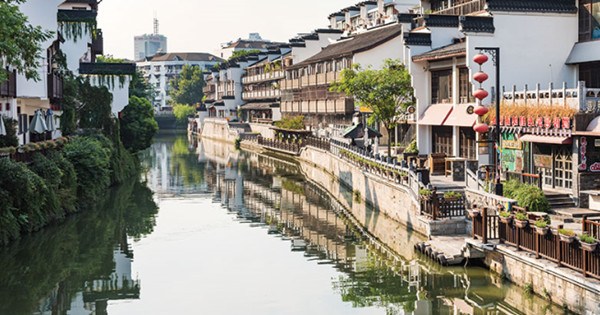
Within the heart of Nanjing lies Fuzimiao (夫子庙), a small district named after the Confucius Temple located within it. Aside from being a hotspot for historical sites, it is easily identified by the Jiangnan-style of architecture that lends the area much of its charm, surrounding the Qinhuai River (秦淮河) as it meanders through the district. Visitors need only look at almost any building in the area to see what the architecture entails.
Taking the "jiang" from "Changjiang" (长江, known as the Yangtze River) and mashing it with "nan" for south, you get Jiangnan (江南), a basic description for the area south of the Yangtze where this architectural style originated. It includes Shanghai and the southern parts of Anhui and Jiangsu provinces, along with northern Jiangxi and Zhejiang.
Although many of the buildings in Fuzimiao date back to the Qing Dynasty (1616 – 1911), much of the area was rebuilt in 1985 as part of a restoration project to give the area its historical cred. Well-heeled tourists can look into prices of trips on river-boats; the same goes for hotels in the area, but unlike the river-boats, accommodation can be found cheaper if you book ahead.
But beyond the atmosphere of the bustling crowds, clean white surfaces, clipped terraces, and languid riverboats, a key attraction of the area is its history of romance and intrigue. This location was home to the Eight Beauties of Qinhuai, courtesans whose history has become intertwined with legend to produce some of the most compelling tales of the era.
The question of whether these women were prostitutes is not an easy one to answer; they were regarded as patriotic, beautiful women whose company was desired by men—though precisely what "company" entailed is open to debate. Literary recollections suggest that they provided educated conversation and decoration at social functions, and would later fall in love and in some cases marry.
The tragedies and triumphs of all eight beauties could occupy thousands of words of prose (and have), but none more so than Li Xiangjun (李香 君), who lived in the 17th century and became a key character in the Kunqu opera Peach Blossom Fan (《桃花扇》). The tale is a love story between Li and her lover Hou Fangyu (侯方域) that uses the downfall of the Ming Dynasty (1368 – 1644) as a backdrop. Perhaps unsurprisingly, given the way history is used, the tale has become first and foremost one of patriotism, with romance as a key theme.
Hou was a member of a reform movement that aimed to tackle corruption in Nanjing under the Ming, but in the opera, he becomes caught in conflicts and is separated from Li after their betrothal.
Spoiler alert: though she is packed off to marry someone else, she prevents the wedding with a failed suicide attempt. The two protagonists do get together for a while but eventually opt for monastic lives because they decide it's selfish to satiate their own desires amid such chaos.
Visitors to Fuzimiao can stop in at Li Xiangjun's home, where much of her romance with Hou Fangyu no doubt transpired. From the windows and balcony, visitors have views of the Qinhuai River and the tour boats that meander past. While there, make sure you find the out-of-the-way hole in the ground, with a short flight of stairs leading to the pontoon where Li could board the boats coming along the river. Also, take note of the pictures on the walls—aside from stone carvings on the bottom floor depicting romantic scenes from the opera, there are collections of photographs of the various depictions of Li in popular media over the decades.


















































